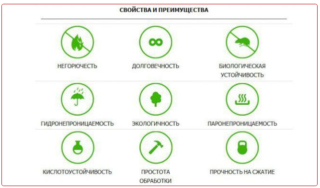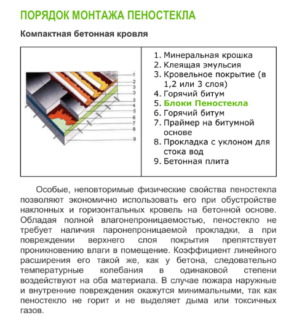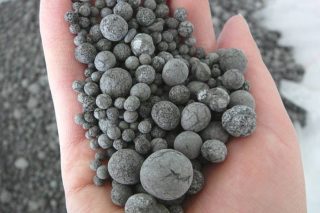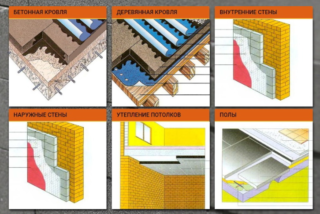Insulation of private and multi-apartment buildings pays great attention already at the stage of building construction. Without high-quality thermal insulation, a draft, mold and other negative phenomena will form in the room. It is difficult to maintain the optimum temperature in a building without thermal insulation, so it is important to choose the best material for insulation. Foam glass is considered to be easy to install, strong, durable and effective heat insulator. Before use, it is necessary to study the advantages of the material, methods of its installation and operating conditions.
Main varieties
Foamed glass is a heater that combines the advantages of two materials at once. Strength and brittleness are characteristic of silicate glass, and lightness is characteristic of foam.
In the production, the silicate mass is heated, after which a gas-forming substance is added to it. Under the influence of high temperatures, melting and the formation of small bubbles in the mass occur. Thanks to this technology, a material with a high level of heat resistance is obtained.
In thermal insulation works, the following types of foam glass are used:
- Tiled. It is produced in the form of a plate with closed cells in a foamy structure. It is used in the insulation of socles, facades, ceilings, foundations. The standard dimensions of the plate are 45 × 60 cm. The thickness varies from 6 to 12 cm. It can withstand severe loads, does not shrink and does not deform.
- Granulated. Available in the form of microporous granule spheres of various sizes. Granules can be used to insulate internal walls and floors.
Technical characteristics, depending on the type of release, practically do not differ. When choosing granules or plates, the master relies on the convenience of work and the appropriateness of using one form or another.
The material is universal, therefore it is used for insulation of brick, wooden, concrete and other houses.
Characteristics of foam glass
Any heat insulator must maintain a comfortable temperature in the room. For this, the insulation has the following properties:
- Thermal conductivity. It should be low. In foam glass, this figure is 0.04 W / m * s. Foamed glass protects against heat loss better than wood and mineral wool installed inside the house.
- Strength. The strength index of foam glass is 0.5 - 1.2 MPa. Over time falls. Resistance to mechanical stress is low.
- Soundproof properties. Foam glass can absorb sound waves with a power of 45-55 decibels.
- Temperature characteristics. It works under extreme conditions and can withstand from -200 ° to + 300 ° C.
- Vapor permeability. It can be used as a vapor barrier.
- Moisture resistance. Does not absorb moisture and does not change its properties upon contact with liquid.
- Resistance to microorganisms, insects and rodents. Mold does not form.
- Chemical resistance. Does not interact with acids, alkalis, gases. Foam glass from chemical compounds is affected only by hydrofluoric acid.
- Environmental friendliness. The material is safe, does not emit harmful substances, is not subject to burning.
All these unique characteristics are achieved by combining the properties of two materials and foaming them into a single mass.
Foam glass is produced by various large manufacturers. Among them are Knauf, Penosital (Perm), Pennosteklo (Moscow), AiSiM Glass (Samara) and others. Material should be ordered from verified manufacturers, as goods of unknown origin may not meet the declared characteristics.
Advantages and disadvantages
 Foam glass is often used as a heater in country houses, apartments, saunas, and factories. This is due to the following positive qualities of the material:
Foam glass is often used as a heater in country houses, apartments, saunas, and factories. This is due to the following positive qualities of the material:
- Good thermal insulation properties. They are explained by the structure of the material in the form of closed cells.
- A wide range of applications. It can be used for insulation of walls, frame structures, floors, facades, roofs, communication systems.
- Lifetime. Service life reaches 100 years without loss of performance.
- Quality soundproofing. It damps extraneous sounds well and does not require the installation of an additional layer of soundproofing.
- Ease of installation. For work special skills, abilities and professional equipment are not required.
- Ecological and fire safety. The material does not burn, but can only melt. Does not emit gas, smoke and toxic components.
Due to its advantages, foamglass insulation is one of the safest and most qualitative methods of thermal insulation. But there are also disadvantages that need to be considered when choosing a heater and in working with it:
- Cost. This is one of the most expensive heat insulators.
- Low impact strength. Strong impact may crack. This indicator is affected by the glass structure.
- Low vapor permeability. Fungi and other biological elements do not form in the material, but the surface covered with foam glass can become a focus of infection. This is due to the lack of air exchange.
Despite the disadvantages, foamed glass is actively used in insulation.
Foam glass application
Good thermal insulation properties and high strength distinguish foamed glass from other materials. A different form of release allows you to use it for a socle, load-bearing walls, facades, pipelines, foundations. Due to its low absorption of liquid, foamed glass can be installed in rooms with high humidity - basements, attics, baths and saunas. Granules can be added to concrete for additional insulation.
The ability to cut with an ordinary knife allows you to produce plates of the right size. They also hold plaster and wall finishes well.
In addition to decoration and insulation of residential premises, foam glass is used in industry. They can insulate production workshops and equipment that operates at elevated temperatures.
Insulation technology
 To create high-quality thermal insulation with foam glass in the house is easy even for a novice specialist. To do this, observe the installation technology:
To create high-quality thermal insulation with foam glass in the house is easy even for a novice specialist. To do this, observe the installation technology:
- Fastening of plates is carried out on special glue. It must be applied to the back of the slab and side walls, and then evenly distributed over the entire surface.
- If the back surface of the sheet is uneven, glue is applied with flip flops.
- Fixing to a tree is done with dowels. This is due to the fact that under the influence of moisture and temperature the tree expands.
- Installation on a vertical surface is carried out using the building level and the lower bar.
- The first row of the heat insulator is placed on the support profile. After finishing work, you can delete it.
- Plates are stacked flush. After the glue has completely dried, they are strengthened with special dowels.
Compliance with installation requirements will increase the efficiency and durability of the insulation.





